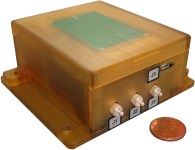
December 9 – 22, 2006
Space Shuttle Discovery
This was the twenty-third flight of Invocon hardware on the Space Shuttle. The STS-116 mission marked the second mission to continue ISS construction after the loss of Columbia during STS-107. During this mission, the Discovery crew performed rewiring tasks to connect the new solar arrays to the power system. Two IVC systems were present on the orbiter and another was attached to the truss.
Below is a list of the IVC systems that were present on Atlantis during the mission. The EWB MicroTAU-WLE system is the IVC system used for detecting impacts on the leading edge of the Orbiter’s wing.
| 44 | EWB MicroTAU™ | Wing Leading Edge |
| 12 | MicroSGU™ | Aft Section |
| 1 | EWIS | Network Control Unit |
Enhanced Wide-Band Micro-Miniature Tri-axial Accelerometer Unit

This is the fourth flight of the EWB MicroTAU system, a high-speed data acquisition network for dynamic acceleration sensing and recording. On STS-116, 44 units were used to detect, locate, and characterize impacts on the RCC panels on the wing leading edge.
Click here for more information about the EWB-MicroTAU system.
Micro-Miniature Strain Gauge Unit

Twelve Invocon MicroSGU™ sensors were installed in the engine compartment to measure the stresses imparted to the trunnion arms on the Space Shuttle Main Engines (SSMEs).
This makes the tenth consecutive flight of the MicroSGU system starting with STS-109.
Click here for more information about the MicroSGU system.
Mission Navigation
